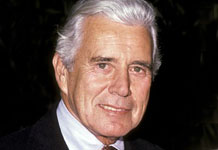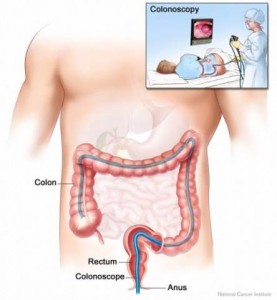John Forsythe, “Dynastic” Actor, Dies

John Forsythe, the actor best known not for one, but for three classic TV roles has died at the age of 92. Forsythe died of pneumonia, as a complication of his nearly four year battle with colon cancer. Forsythe first became a household name on the 1957-62 show Bachelor Father, playing Bentley Gregg, a bachelor whose social life is turned upside down when he becomes the guardian of his young niece. Later he was the unseen voice of “Charlie” in Charlie’s Angels, both on the big screen and in the original TV series. Perhaps his biggest role was as oil tycoon Blake Carrington in one of TV’s most successful prime-time soap operas, Dynasty, which aired from 1981 to 1989.
We recently did an overview of colon cancer when we discussed the diagnosis and treatment of colon cancer in tenor Placido Domingo last month. This time, I thought we’d touch on colorectal cancer screening. Colorectal cancer (cancer of the colon or rectum) is the second leading cause of cancer-related deaths in the United States, among cancers affecting both men and women, reports the Centers for Disease Control and Prevention (CDC). The CDC also reports that at least 60 percent of deaths from colorectal cancer could be avoided if everyone aged 50 or older had regular screenings. Routine colonoscopy to look for early signs of cancer should begin at age 50 for most people—earlier if there is a family history of colorectal cancer, a personal history of inflammatory bowel disease, or other risk factors. The doctor can advise patients about how often to get a colonoscopy.
What is a colonoscopy?
Colonoscopy is a procedure used to see inside the colon and rectum. Colonoscopy can detect inflamed tissue, ulcers, and abnormal growths. The procedure is used to look for early signs of colorectal cancer and can help doctors diagnose unexplained changes in bowel habits, abdominal pain, bleeding from the anus, and weight loss.
How is a colonoscopy performed?
During colonoscopy, patients lie on their left side on an examination table. In most cases, a light sedative, and possibly pain medication, helps keep patients relaxed. Deeper sedation may be required in some cases. The doctor and medical staff monitor vital signs and attempt to make patients as comfortable as possible.
 The doctor inserts a long, flexible, lighted tube called a colonoscope, or scope, into the anus and slowly guides it through the rectum and into the colon. The scope inflates the large intestine with carbon dioxide gas to give the doctor a better view. A small camera mounted on the scope transmits a video image from inside the large intestine to a computer screen, allowing the doctor to carefully examine the intestinal lining. The doctor may ask the patient to move periodically so the scope can be adjusted for better viewing.
The doctor inserts a long, flexible, lighted tube called a colonoscope, or scope, into the anus and slowly guides it through the rectum and into the colon. The scope inflates the large intestine with carbon dioxide gas to give the doctor a better view. A small camera mounted on the scope transmits a video image from inside the large intestine to a computer screen, allowing the doctor to carefully examine the intestinal lining. The doctor may ask the patient to move periodically so the scope can be adjusted for better viewing.
Once the scope has reached the opening to the small intestine, it is slowly withdrawn and the lining of the large intestine is carefully examined again. Bleeding and puncture of the large intestine are possible but uncommon complications of colonoscopy.
Removal of Polyps and Biopsy
A doctor can remove growths, called polyps, during colonoscopy and later test them in a laboratory for signs of cancer. Polyps are common in adults and are usually harmless. However, most colorectal cancer begins as a polyp, so removing polyps early is an effective way to prevent cancer.
The doctor can also take samples from abnormal-looking tissues during colonoscopy. The procedure, called a biopsy, allows the doctor to later look at the tissue with a microscope for signs of disease.
The doctor removes polyps and takes biopsy tissue using tiny tools passed through the scope. If bleeding occurs, the doctor can usually stop it with an electrical probe or special medications passed through the scope. Tissue removal and the treatments to stop bleeding are usually painless.
A newer colonoscopy technique is called a “virtual colonoscopy.” With this kind of colonoscopy, images of the large intestine are taken using computerized tomography (CT) or, less often, magnetic resonance imaging (MRI). A computer puts the images together to create an animated, three-dimensional view of the inside of the large intestine. President Obama had this kind of colonoscopy at this year’s physical examination. We’ll save a discussion of this procedure for another blog.
For more information:
| Resounding Health(tm) Colonoscopy |

























0 comments